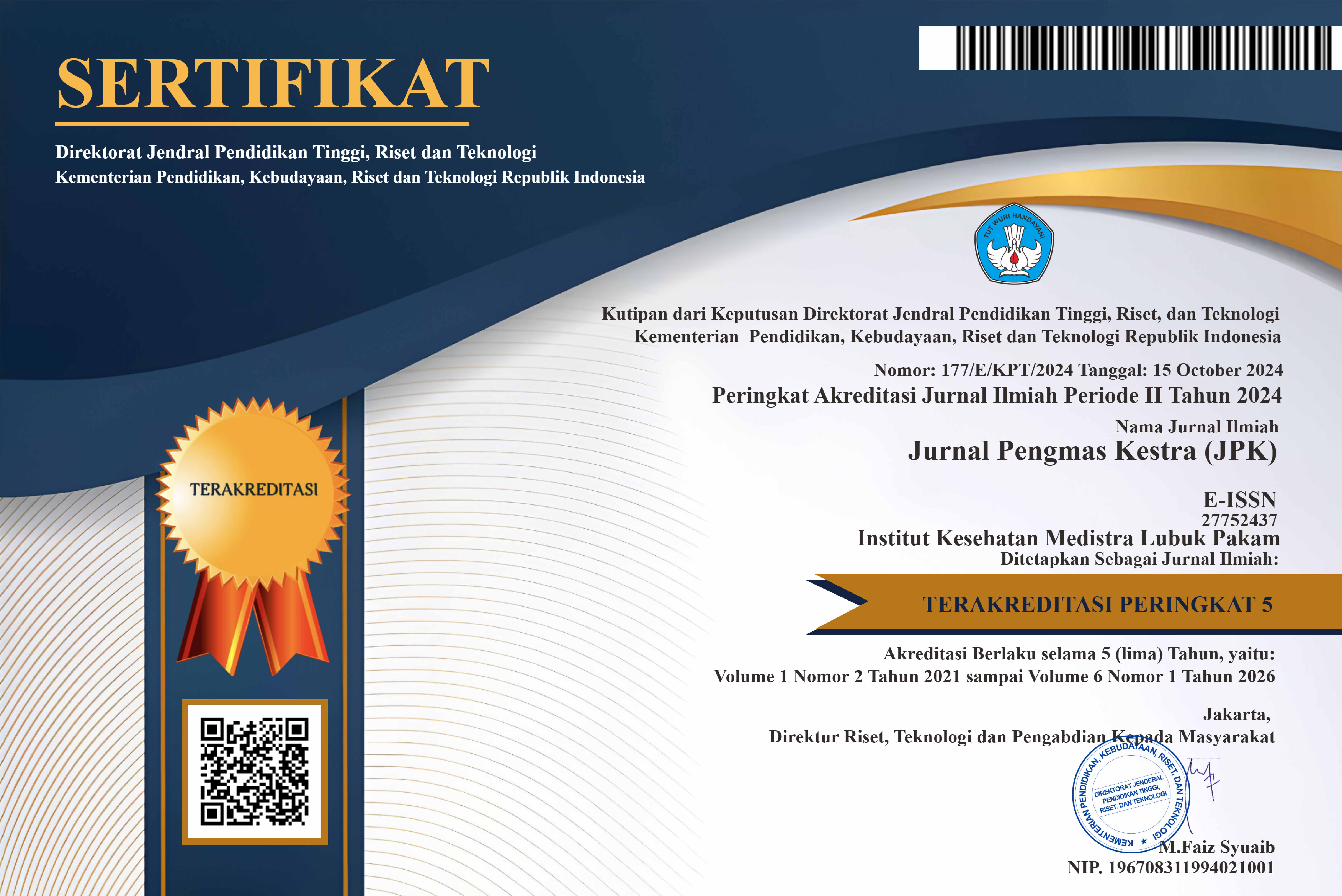Education on Correct Cough Ethics in An Effort to Prevent the Transmission of Pulmonary TB Disease at Galang Health Center
DOI:
https://doi.org/10.35451/jpk.v4i1.2179Keywords:
Education, Correct Cough Etiquette, Pulmonary TB SufferersAbstract
Pulmonary tuberculosis (TB) is a type of dangerous and infectious disease that is very important and causes serious health problems in many countries, including Indonesia. This disease is caused by the bacteria Mycobacterium tuberculosis which can attack through the air when another infected person sneezes, coughs or talks. Pulmonary TB can infect anyone, especially individuals who live in densely populated areas and have weak immune systems. Implementing correct cough etiquette is very important to prevent transmission of pulmonary TB. Correct cough etiquette includes the habit of covering your mouth and nose with a tissue or the inside of your elbow when coughing or sneezing, and washing your hands afterwards. The purpose of this education is to examine the importance of education regarding correct cough etiquette and increase knowledge of pulmonary TB sufferers at the Galang Community Health Center while also supporting the government's efforts to achieve the target of eliminating TB as a public health problem in Indonesia. The method used includes a pretest before implementing education, followed by an explanation of material regarding correct cough etiquette, and then ending with a posttest. This educational activity was carried out at the Galang Community Health Center, Deli Serdang Regency with the participation of 24 participants. Before the education was carried out, the majority of participants had poor knowledge (60%), but after the education, the majority of participants showed good knowledge (95%) and understood the principles of correct cough etiquette. It was concluded that the education participants' knowledge increased, whereas previously the majority was lacking and after the education was given the majority had good knowledge. It is recommended that we continue to apply good cough etiquette and it is hoped that there will be a significant reduction in the transmission of pulmonary TB so that it can improve the quality of public health.
References
Alhidayat, Widodo, D., & Mariana, A. (2022). Penyuluhan etika batuk dan bersin dimasa pandemi covid-19 pada anak-anak panti asuhan Al-Akbar Kota Pekanbaru. Jurnal aplikasi riset kepada masyarakat, 3(1), 12– 18.https://doi.org/10.55583/arsy .v3i1.277
Burhan, E., Isbaniah, F., & YM Sinaga, B. (2021). Tuberkulosis Pedoman Diagnosis dan Penatalaksanaan di Indonesia. In Perhimpunan Dokter Paru Indonesia.
Faturrahman, Y., Setiyono, A., & A, R. S. (2021). Analisis faktor risiko kejadian tuberkulosis di wilayah puskemas Kelurahan Cipinang Besar Utara Kota Administrasi Jakarta Timur. Jurnal Kesehatan Komunitas Indonesia, 17(2), 346– 354. https://doi.org/10.37058/jkki.v1 7i2.3893
Hapipah, H., Istianah, I., Arifin, Z., & Hadi, I. (2021). Edukasi etika batuk yang benar sebagai upaya pencegahan penyakit TB paru di Dusun Aik Nyet Lombok Barat. Jurnal Abdimas Kesehatan Perintis Journal, 2(2), 17–21. https://jurnal.upertis.ac.id/index .php/JAKP/article/view/534
Ramdan, M., Lukman, M., & Platini, H. (2020). Pengetahuan, sikap dan etika batuk pada penderita tuberkulosis paru. Holistik Jurnal Kesehatan, 14(2), 232–239. https://doi.org/10.33024/hjk.v1 4i2.2395
Rusnedy, R., & Muhtadi, W. K. (2022). Sosialisasi Etika Batuk dan Bersin yang Benar dan Pemanfaatan Herbal untuk Pereda Batuk. Amalee: Indonesian Journal of Community Research and Engagement, 3(1), 139–146. https://doi.org/10.37680/amalee .v3i1.1292
Samhatul, I., & Bambang, W. (2018). Penanggulangan Tuberkulosis Paru dengan Strategi DOTS. Higeia J Public Heal Res Dev, 2(2),331–341.
Widiyono, Bahri, A. S., & Candrarini. (2022). Health Care Health Care. Health Care Collector, 30(5), 10– 11.https://lotusjournal.org/index .php/jrahc/article/view/13
Downloads
Published
Issue
Section
License
Copyright (c) 2024 Rahmad Gurusinga, Albrianto Yunus, Tomy Putra

This work is licensed under a Creative Commons Attribution 4.0 International License.
Copyright in each article is the property of the Author.




















